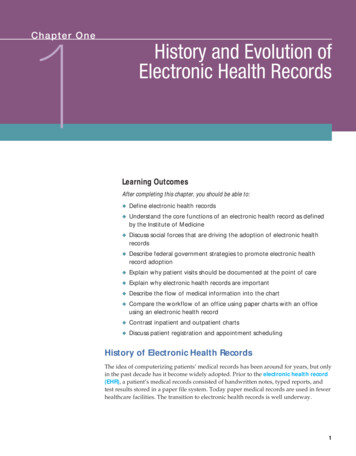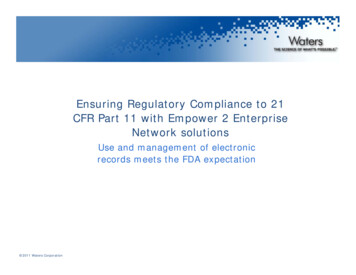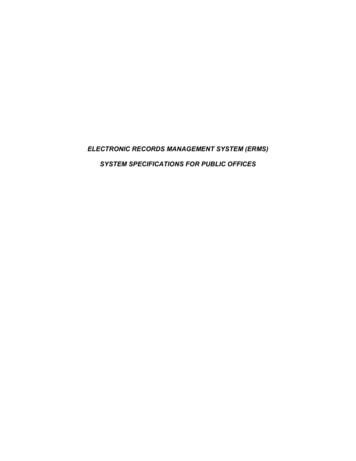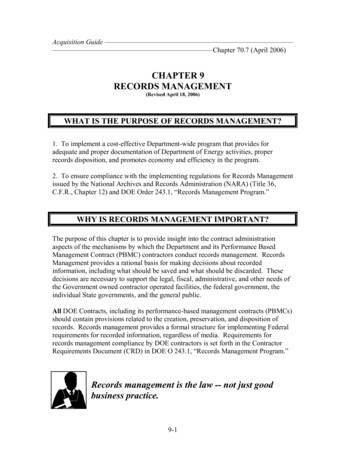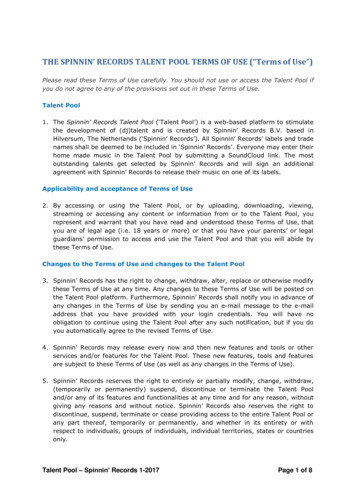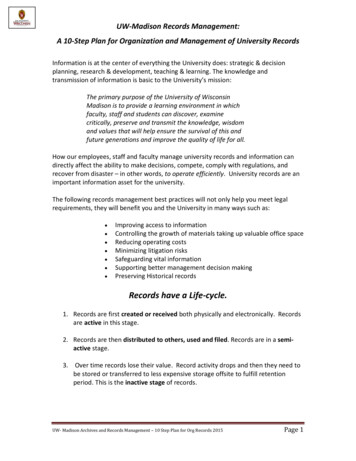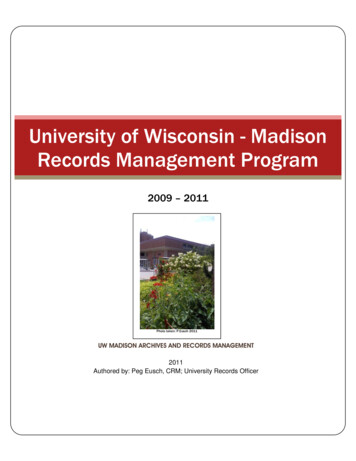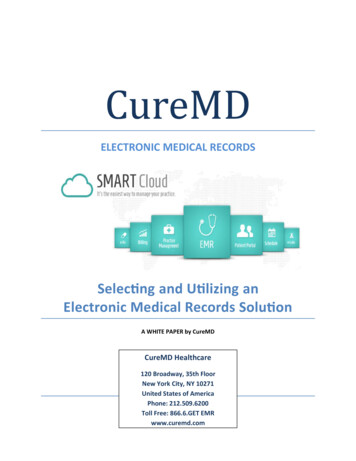
Transcription
ELECTRONIC MEDICAL RECORDSSelec g andzing anElectronic Medical RecordsA WHITE PAPER by CureMDCureMD Healthcare120 Broadway, 35th FloorNew York City, NY 10271United States of AmericaPhone: 212.509.6200Toll Free: 866.6.GET EMRwww.curemd.comOverviewn
Health IT received a major boost in 2009 with the introduction of theMeaningful Use program. Launched under the HITECH Act (HealthInformation Technology for Economic & Clinical Health), the program aimedto improve efficiency and care quality of the Healthcare system throughadoption of Electronic Medical Records (EMRs).Anticipating long term benefits of Electronic Health Records, media andacademics alike hailed this legislation as an instrumental achievement by theU.S government and health policy‐makers. It is expected that the adoption ofEMRs will improve the quality of care, patient‐doctor engagement and makehealth care accessible for a greater number of people.TheMeaningful UseProgram is aninitiative through whichproviders can qualify for upto 44,000 for Medicare and 63,750 for Medicaid inincentives, over a period offive years by utilizingapproved and certifiedsystems.How has the medical community reacted to this change? Over the years, theadoption of EMRs has gradually increased, as more and more care providershave realized the benefits of EMRs. Currently, an increasing number of providers are in the process ofendorsing health information technology and/or planning to implement it in the future.Objectives of this White PaperThe aim of this white paper is to facilitate understanding of EMRs, so that readers know what thesesystems do, how do they relate to them and the benefits that they can expect. Furthermore, it providesa step by step guide to simplify the transition from paper.
ALL YOU WANT TO KNOW ABOUT EMRs9 Integrated Delivery Networks9 Federally Qualified Health CentersUnderstanding the technologyQ: DifferencebetweenEMR and EHR?An Electronic MedicalRecord is the record ofpatients derived frommedical information andhistory in a single practice.An Electronic Health Recordis a patient’s recorddesigned to beinteroperable amongdifferent entities so thatinformation can be sharedto increase care quality.An ElectronicMedical Record(EMR) is a digitalversion of atraditional paper‐based medicalrecord. EMRsoftware allowspatients’ healthinformation to bestored andexchangedelectronically.ThroughEMRsoftware, care providers can view a patient’smedications, allergies, lab results and socialhistory. When the history of a patient isavailable to a provider electronically, they caneasily determine patterns of illness and decidewhat needs to be done before patient’s healthdeteriorates.Myth 1: EMRs are suitable only for largescale practicesEMRs create value for practices of all sizes asthey allow for scalability and customizability tosuit the existing administrative and clinicalworkflows of any practice setting.9 Small (1‐4 MDs)9 Mid‐sized (5 MDs)9 Large (20 MDs) or Multi‐Specialty9 Practices supported by Hospitals9 Academic Medical Centers9 Management Service OrganizationsMyth 2: Paper based Medical Records areeasier to handleUsing paper has always been the traditionalway a medical practice does things. It is difficultto let go of your comfort zone. However, whendeciding on whether to make the transition;you must bear in mind how both methods ofdocumentation compare.Paper Based MedicalRecordsTime consumingSusceptible to inaccuraciesPhysical storage requiredDifficult to find relevantdocumentsIncreased overheadsElectronic MedicalRecordsTime savingAccurateElectronic storageSimplified searchCost savingsMyth 3: EMRs are only made for somespecialtiesLike most things in life, there is no “one sizefitsall” perfect solution. Anticipating this need,health IT organizations have created solutionsthat come in different versions for differentpractices depending on their size and thenumber of specialties involved. Single‐specialty: Single‐specialty specificEMRs will not be developed according tothe specifications of different specialties.They are configurable to suit the specialtyspecific workflows of physicians. Multiple‐Specialty: Multi‐specialty EMRsare developed for practices which employ
more than one specialty. If a practice employs a dermatologist, an oncologist and a cardiologist, thenthe use of multi‐specialty EMRs would be highly beneficial for it, since the software is customized tospecialty specific usage.Myth 4: A costly investment with slowreturnsToday, there are free EMRs available in themarket as well, though they have limitedfunctionality as compared to established healthIT vendors. The table below compares thefeatures for both systems.Free EMRLimited featuresNo customizationAnnoying pop‐ups(Ad‐supported)No specialty systemsPaid EMREnhanced featuresHighly customizableNo advertisementsLimited training andsupportDedicated team of supportSingle and multi specialtyspecificNo Practice ManagementLimited or no backupsentities are able to safeguard patient healthinformation.Reduce Time and CostThe cost of paper along with costs associatedwith maintaining software, hardware andstorage space are considerably reduced withthe usage of Electronic Medical Records. Theneed for data‐entry with every patient visit isalso minimized since the data is entered onlyonce, saving valuable time.Swift & Informed Decision makingThe ability of EMRs to match patient’s medicalhistory with known allergies, drugs and diseasesfor reactions allows for better decision making,minimal errors and accurate diagnosis, whilesaving time for doctors and patients alike.Yes on all accountsNo clinical DecisionsupportSecondly, EMRs contribute both towardsimprovement in the clinical and administrativemanagement of the practice. Some of thewidely recorded improvements that EMR usershave reported include the following:Greater Patient Safety and Care QualityUsage of Electronic Medical Records promotespatient safety and care quality by minimizingrisks associated with manual errors such asillegible handwriting, no follow up alerts,drug/allergy interactions, With ElectronicMedical Records that are in compliance withHIPAA (Health Information Portability andAccountability Act) Security and Privacy Rules,Accessibility of Medical RecordsAccess to the patient’s medical records throughEMR is important for doctors to ensure qualitycare delivery. For clinicians, ordering andreceiving test results or prescribing medicationcan be done from anywhere.Data MiningElectronic Medical Records allow tracking ofdata to determine trends and patternspertaining to population health and preventivecare measures against diseases, using artificialintelligence, machinelearning, statistics,and database systems.
AccountabilityEMRs with built‐in audit trails monitor everyclinical and administrative process to ensuretransparency, accountability and integrity ofpatient health information. This allowsphysicians and relevant regulatory bodies toidentify any misuse of data or other fraudulentactivities.Simplifying the TransitionStep 1Step 2Step 3KnowYourPracticeExploretheMarketDecideWhatYou WantStep 1: Know your PracticeIf you have decided in favor of transitioning to EMRs, you will have to undergo a series of steps toensure that you have a product that will maximize returns both in terms of the quality of care andpractice revenues. This process can take time, usually between 1 to 2 months on an average (the timeperiod may vary depending on the vendor) starting from exploring the market to implementationprocesses such as data migration, trainings and generation of customizable workflows and systems.Thus, you should try to start the process as soon as possible after preliminary research and duediligence.Identify reasons for transitioning frompaper. Objectively analyze the problem in thepractice and take help from an HIT consultantto identify how these problems can be solvedby an EMR. All EMR vendors offercomprehensive EMR demos to help you assessthe benefit prior to making a decision.Ensure financial stability. You have to makesure that there is a set budget put aside toavoid unnecessary delays in acquisition.Education is the key. Every relevant person inthe office should be educated about upcomingchanges. Special trainings should be held onhow to use the software. Provide basicguidelines to the management and how to bestuse EMR software.
Question the vendor. Ask questions aboutTest the software. Make sure that you testevery issue you face with the software and howthey think the issue may be resolved. Put inplace a single person who will coordinate withthe vendor and solve issues at the workplace.the software before it is actually supposed to‘go live’. Initiate the use of EMR throughout thepractice a couple of months before the go‐livedate so that every issue that comes withoperating the software is handled before andeveryone gets to learn how to use the softwareeffectively.Step 2: Explore the MarketSurveys suggest that at times physicians do not ask or take interest in product details, rather basing theirpurchase decision on low cost or visually appealing solutions. Providers must choose an EMR vendorthat can fulfill their long‐term practice requirements. Selecting a standalone Practice Management orEMR system, instead of an integrated system can cause compatibility and workflow related issues.Practice Management SoftwareIntegrated practice management software canhelp streamline administrative and financialoperations of care delivery organizations –providing unprecedented opportunities forproductivity, collaboration and growth.Integrated access across patient rative/financial reporting and workflowmanagement connects front and back officeoperations, drives efficiency while eliminatingreimbursement delays and communicationbarriers. With integrated Practice Management,providers can do what they do best –providingquality care and not worrying about managing abusy practice.Patient PortalFacilitate your patients to securely requestappointments and prescription refills ive test results as they become available,utilize educational material and update theirhealth status, history, demographics andinsurance information while subscribing tovaluable electronic tools and services.Medical Billing FunctionalityElectronic Medical Records with built‐in billingfunctionality can allow for quick chargecapturing and claim submission directly fromthe EMR software. Through this integration,providers can check claim statuses in real‐time,so they know exactly when they are gettingpaid.
Features of a good EMRPoint‐and‐ClickReducing cognitive overload, supporting uniqueworkflows and clinical approaches – a clicktechnology enables accurate, complete andfaster encounter documentation.Computerized Physician Order EntryA CPOE backed by EMRs is extremely valuablefor doctors. When doctors issue orders throughCPOE, the presence of patient’s medical historythrough EMRs is vital in reducing many possibleerrors. If the doctor is ordering certainmedication for the patient, then the access andavailability of the patient’s previous drug usageand overall medical history helps the doctordecide whether the prescription was necessaryor it might have caused an allergic patientreaction.The purpose of a CPOE is fulfilled when everyelement of clinical information is securely andefficiently integrated between differenthealthcare stakeholders such as hospitals,practices, clinics and laboratories.CustomizabilityIt is important for any EMR software to becustomizable so that practices with differentspecialists can use the software. Some of thecommon specialties include:CardiologyDermatologyEndocrinologyFamily Practice / PrimaryCareEmergency MedicineGastroenterologyGeneral SurgeryInternal MedicineInfectious atricsPodiatryRheumatologyStep 3: Decide what you wantQ: Do I need toupgrade existinghardware andsoftware?Not at all. With Web‐basedtechnologies, you don’t have tohave the latest system or spendmoney on updating softwares.Your data will be securelystored on web‐based serverswhich you can access from anylocation with youridentification.There are thousands of Electronic Health Records vendors in the markettoday, which can make decision making difficult for providers. Thefollowing should help you decide which vendor you will benefit frommost.HardwareMany practices need to upgrade existing hardware to run EMRs. Vendorsgive out a list of items you need to purchase to get things going. This iswhy it is even more important to look for a vendor who offers web‐based services that require limited hardware installation.
MaintenanceDemonstrationsMany vendors charge a percentage of the firstpayment to cover costs of softwaremaintenance and updates. It is thereforeimportant to see if the increased costs due tomaintenance are worth your money. Talk to thevendor about this and consult with people whouse this vendor. Is the maintenance and updateservice as good as they say?A vendor who provides detailed demonstrationsfor their products will further simplify yourdecision making. Feel free to ask themquestions that come to mind.Web‐based TechnologyWeb‐based technology enables providers toaccess EMRs regardless of location on anydesktop or laptop computer, tablet andSmartphone. Such technologies reduce the costof purchasing, maintaining and updatinghardware and software at the practice.Support and TrainingIt is imperative that you choose a vendor whoprovides live, online and built‐in softwaresupport services. Many EMR vendors nowprovide support services with dedicated clientaccount managers.Ratings/Certifications/AlliancesGoogle the vendor. Look for ratings fromcredible sources. Take a look at the vendorwebsite and see if they are compliant withMeaningful Use, if they are certified withcredible entities and follow the industrystandards. Some of the important certificationsto look for are:99999ONC‐ATB 2011/2012CCHITHIPPA complianceSureScripts Gold CertificationISO 9001:2000, 27001:2005Some of the standards to look for include:HL7, ANSI X12, LOINC, SNOMED CT, DICOM,NCPDP, ICD9/10, CPT4 and PDF/H.Also, remember to ask for references beforemaking a final decision.We hope these guidelines will enable you to select the best suited EMR for your practice.
An Electronic Medical Record is the record of patients derived from medical information and history in a single practice. An Electronic Health Record is a patient's record designed to be interoperable among different entities so that information can be shared to increase care quality.
